Abstract
A lead-free 0.94(Na0.5Bi0.5) TiO3-0.06 BaTiO3 (BNT-BT) thick film, with a thickness of 60 μm, has been fabricated using a tape-casting method. The longitudinal piezoelectric constant, clamped dielectric permittivity constant, remnant polarization and coercive field of the BNT-BT thick film were measured to be 150 pC/N, 1928, 13.6 μC/cm2, and 33.6 kV/cm, respectively. The electromechanical coupling coefficient kt was calculated to be 0.55 according to the measured electrical impedance spectrum. A high-frequency plane ultrasound transducer was successfully fabricated using a BNT-BT thick film. The performance of the transducer was characterized and evaluated by the pulse-echo testing and wire phantom imaging operations. The BNT-BT thick film transducer exhibits a center frequency of 34 MHz, a −6 dB bandwidth of 26%, an axial resolution of 77 μm and a lateral resolution of 484 μm. The results suggest that lead-free BNT-BT thick film fabricated by tape-casting method is a promising lead-free candidate for high-frequency ultrasonic transducer applications.
1. Introduction
Ultrasound imaging system have been widely used for imaging soft tissues, blood vessels, skin and eyes [1,2,3,4], in which ultrasound transducers transmit ultrasound waves into the tissues and receive the resultant echo waves. Due to the differences in acoustic properties of the tissues, the system can generate an image of the tissues based on the reflected waves. As the key component of ultrasound imaging system, ultrasound transducers ultimately determine the spatial resolution of the imaging system. High frequency and broadband ultrasound transducers have been desired for clinical and biophysical applications [5,6], because they can generate narrow ultrasound beams and have superior spatial resolution [7]. The fabrication of high-frequency ultrasound transducer is strictly reliant on the technology level of the piezoelectric materials and manufacturing techniques. It is well known that the selection of piezoelectric materials has a significant influence on the performance of high-frequency transducers.
For the past several decades, PZT-based (Pb[ZrxTi1-x]O3, abbreviated as PZT) materials have been commercially applied in the ultrasound imaging field because of their excellent piezoelectric properties [8,9]. However, the element lead (Pb), as a heavy metal, is both harmful to human health and environmentally hazardous. Thus, in recent years, lead-free piezoelectric materials have drawn increasing attention around the world. Among the lead-free piezoelectric materials, bismuth sodium titanate, Na0.5Bi0.5TiO3 (abbreviated as BNT) is one of the most outstanding materials, as it has a high Curie temperature (Tc = 320 °C) and stable electrical properties [10]. According to the literature, bulk BNT-based ceramics have been applied in various applications such as high-frequency ultrasound transducers for medical applications, piezoelectric actuators and ultrasound transducers for nondestructive evaluation [11,12,13].
To enhance the electrical properties of BNT-based polycrystalline ceramics, (Bi0.5Na0.5) TiO3- x BaTiO3 (abbreviated as BNT-BT) binary system piezoelectric ceramics have been thoroughly studied for years. The research indicates the ceramics transform from rhombohedral phase to tetragonal phase, and the morphotropic phase boundary (MPB) exists at x = 0.06–0.07; and thus the ceramics exhibit the optimized piezoelectric characteristics.
In traditional fabrication procedures of high-frequency transducers, it is challenging and time-consuming to lap down the bulk piezoelectric materials, including piezoelectric ceramics or crystals, to the order of tens of microns. Therefore, piezoelectric thick films are low-cost alternatives and the sol-gel and tape-casting technology is convenient for high frequency transducer fabrication.
In this paper, lead-free BNT thick film doped with BaTiO3 was prepared using the sol-gel and tape-casting method, and the structural and electrical properties of the BNT-BT thick film were evaluated. A high-frequency ultrasound transducer was fabricated using the BNT-BT thick film. The performance of this ultrasound transducer was investigated in detail.
2. Materials and Methods
First, 0.94 (Na0.5Bi0.5) TiO3-0.06BaTiO3 thick film (abbreviated as BNT-BT thick film) was prepared using –Bi2O3 (≥99.8%), Na2CO3 (≥99.8%), BaTiO3 (≥99.5%), TiO2 (≥98.0%) analytical-grade powders (Sinopharm Chemical Reagent Co., Ltd., Shanghai, China) as raw materials using the tape-casting method. The slurry for casting was prepared by a series of procedures, which were, in sequence: 7 h ball milling, calcining at 900 °C for 2 h, grinding, addition of solution and dispersant, and bubble defoaming. Then, the prepared composite slurry was cast on a polyethylene terephthalate (PET) film using a casting machine (LYJ-150, Dongfang Taiyang Company, Beijing China). The cast samples were then processed for several steps: First, the samples were left for 24 h at 25 °C for the evaporation of organic solvent; next, the samples were pre-heated at 600 °C for 2 h to remove organic components; and last, the samples were sintered at 1160 °C for 2 h in a high temperature furnace. This produced a lead-free BNT-BT thick film. Cr/Au (50 nm/100 nm) electrodes were deposited on both sides of the BNT-BT thick film using magnetron sputtering technique for characterization measurement.
Surface morphology of the BNT-BT thick film was identified by a field-emission scanning electron microscope (FESEM, Quanta 250 FEG, FEI, Hillsboro, OR, USA). The phase structure of the thick film was characterized using an X-ray diffraction meter (XRD, D/MAX-2400, Rigaku, Tokyo, Japan). The polarization-electric hysteresis loop of the sample was measured using a ferroelectric testing system (TF Analyzer 2000, aixACCT, Aachen, Germany) at 100 Hz. A DC electric field of 4.2 × 106 V/m was applied on the thick film for 60 min, and the poling was executed in a silicone oil bath at 80 °C. The poled samples were aged for a minimum of 72 h at room temperature before any electrical measurements were taken. The longitudinal piezoelectric coefficient d33 was measured using a quasi-static d33 testing device (ZJ-1, CAS, Beijing, China). The electrical impedance characteristics of the BNT-BT thick film were measured using the resonance method by an electric impedance analyzer (HP 4294A, Agilent Technologies, Santa Clara, CA, USA).
The transducer was designed using the KLM model-based simulation software Piezo CAD (Sonic Concepts, Woodinville, WA, USA), shown in Figure 1. The simulation parameters were set as, thickness of 60 μm, element area size of 1 mm × 1 mm, and clamped dielectric constant of 1920. The simulation results indicated the −6 dB center frequency was 35 MHz, bandwidth was 38.9%, and the two-way insertion loss was about 27 dB.
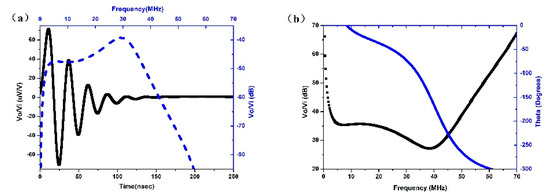
Figure 1.
Modeled performances of transducers based on BNT-BT thick film: (a) the pulse-echo wave and frequency spectrum; (b) the two-way insertion loss.
The transducer fabrication was carried out by the traditional method illustrated in the literature [14,15]. First, Cr/Au (50 nm/100 nm) electrodes were sputtered on both sides of the BNT-BT thick film, and an E-solder 3022 (Von Roll Isola Inc., New Haven, CT, USA) layer with an acoustic impedance of 5.92 MRayls was cured on one side by centrifuged casting as backing layer. The SEM of sample cross-section and the BNT-BT transducer schematic diagram are illustrated in Figure 2.
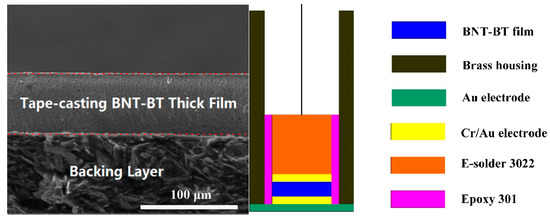
Figure 2.
SEM section image and schematic diagram of the BNT-BT transducer.
Next, the sample was back-lapped to the level of 600 μm thick, and mechanically diced into square posts with area dimensions of 1 mm × 1 mm. Then, a copper wire was welded to the backing layer of the post using conductive epoxy, and the whole post was fixed into a brass housing with SMA connector. Last, Au layer (100 nm) was sputtered across the housing to form a ground electrode. The photograph of the BNT-BT transducer is shown in Figure 3.
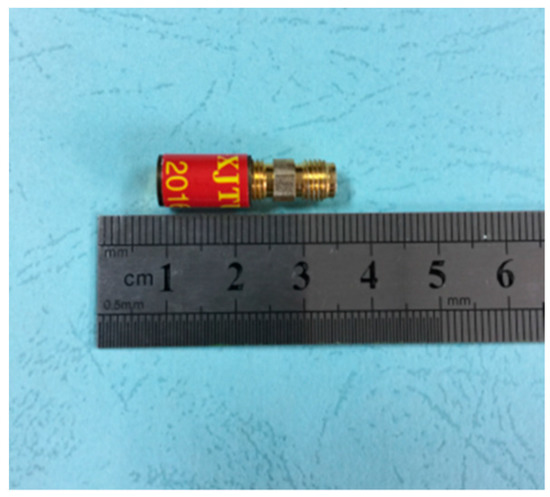
Figure 3.
Photograph of the BNT-BT transducer.
The performance of the BNT-BT transducer was evaluated by a pulse-echo mode operation in de-ionized water tank at room temperature. The transducer was excited by a dual pulser/receiver (JSR Ultrasonics DPR 500, Imaginant Inc., Pittsford, NY, USA) with 200 Hz pulse repetition frequency and 50-Ω damping. The output gain control was adjusted to 14 dB to obtain a signal level between a ±0.2 and ±0.5 V peak. An X-cut quartz crystal block was used as an ultrasound waveform reflecting target and the location of the block was at the focal surface of the transducer.
The reflected waveform was received and digitized by an oscilloscope (InfiniiVision DSO-X 3104A, Keysight Technologies, Inc., Colorado Springs, CO, USA) with 50-Ohm coupling. The frequency spectrum of the received waveform was analyzed by the Fast Fourier Transform (FFT) operation. The center frequency (fc) and the −6 dB fractional bandwidth (BW) could be determined by the following equations:
where fl and fu are the two −6 dB points of the power spectrum, defined as lower and upper band edges of frequency, respectively, at which the magnitude of the amplitude in the spectrum is 50% (−6 dB) of the maximum.
The −6 dB axial and lateral resolutions of the BNT-BT transducer were also measured by wire target imaging. The test was carried on in a deionized water tank at room temperature, in which both the BNT-BT transducer and a tungsten wire target were placed. The Panamatrics 5900PR was used to excite the transducer, and a 12-bit data acquisition card (Gage 12400, Gage Applied Technologies, Lockport, IL, USA) was used to fulfill the analog to digital data conversion and data transfer to computer, working at the sampling frequency up to 400 MHz. The tungsten wire targets were scanned across the BNT-BT transducer sound field with a step size of 5 μm. The amplified echo signals were acquired at each step by the Gage 12,400 and then the data were used to form an ultrasound wire phantom image offline. The −6 dB spatial resolutions of the transducer were then measured from the axial and lateral line spread functions of the recorded wire image.
3. Results
3.1. BNT-BT Thick Film Charaterization
Figure 4 shows the XRD pattern and SEM image of the BNT-BT thick film. From Figure 4a, we can see that the BNT-BT thick film has a single perovskite structure without secondary phase detected, indicating the formation of a solid solution of BNT and BT. Figure 4b shows that the BNT-BT thick film exhibits a dense and uniform structure.
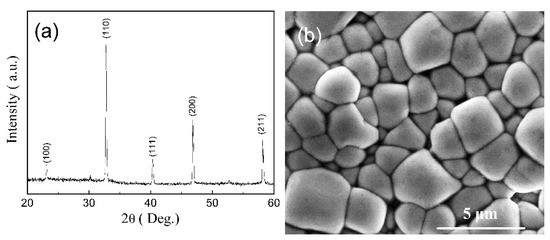
Figure 4.
XRD pattern (a) and SEM surface image (b) of the BNT-BT thick film.
The P-E hysteresis loop of BNT-BT thick film is presented in Figure 5, which indicates that the hysteresis loop is well saturated, and the remnant polarization Pr and coercive filed Ec are 13.6 μC/cm2 and 33.6 kV/cm, respectively.
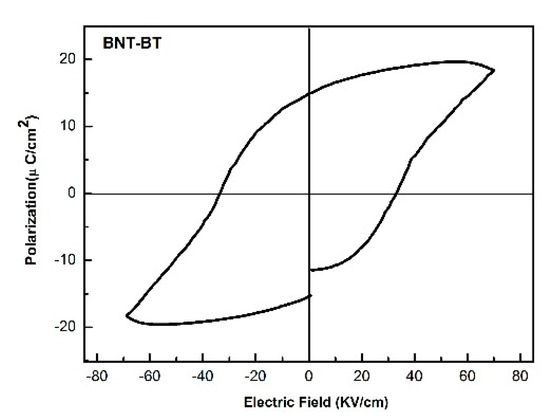
Figure 5.
The P-E hysteresis loop of BNT-BT thick film.
The piezoelectric coefficient d33 is found to be around 150 pC/N. The electrical impedance characteristics are displayed in Figure 6, showing that resonant and anti-resonant peaks are located at 32.5 MHz and 37.9 MHz, respectively.
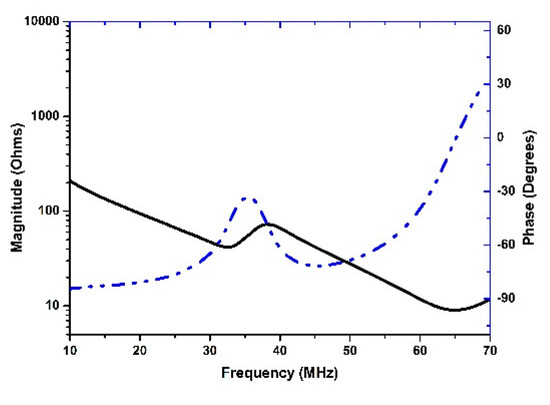
Figure 6.
Measured electrical impedance magnitude (solid line) and phase angle (dash line) of BNT-BT tape-casting thick film.
According to the IEEE standard [16], the longitudinal electromechanical coupling coefficient kt is given by Equation (3):
where fr and fp are series and parallel resonate frequencies. The kt value is calculated to be 0.55, and it is a relatively high value among the reported lead-free thick films [17]. Additionally, the phase curve of the thick film has a peak at 35.2 MHz, which indicates that the center frequency of the BNT-BT thick film transducer is nearby.
3.2. BNT-BT Transducer Characterization
The measured pulse-echo waveform and frequency spectrum of the BNT-BT transducer are shown in Figure 7. The fl and fu were found to be 29.6 and 38.4 MHz, respectively. According to Equations (1) and (2), the center frequency of the BNT-BT transducer was 34 MHz, and the fractional bandwidth at −6 dB was about 26%. The relatively low fractional band width may be caused by the fact that the BNT-BT transducer was measured without a matching layer. Further improvement would be done in the future. Without signal amplification, the amplitude of the pulse-echo waveform is approximately 180 mV.
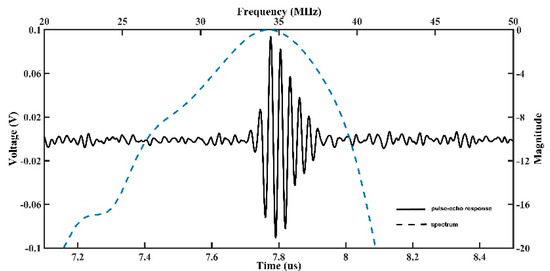
Figure 7.
Measured pulse-echo response and Fast Fourier Transform (FFT) spectrum of the BNT-BT transducer.
The two-way insertion loss (IL) was calculated from the ratio of the received pulse spectrum amplitude to the source spectrum. After the signal loss from transmission into the quartz target (1.8 dB) and the attenuation in water (2.2 × 10−4 dB (mm·MHz2)−1) was compensated for, the insertion loss is described in dB by Equation (4):
where VT and VR are the amplitudes of transmitting and receiving waveforms, respectively, in volt; d is the distance between the transducer and the crystal block in millimeters; fc is the transducer center frequency in Mega Hertz. The minimum insertion loss of the BNT-BT transducer was calculated to be −29 dB.
The measured −6 dB resolutions, also named FWHM (full-width half-maximum) resolutions, were 77 μm and 484 μm for the axial and lateral directions, respectively, as illustrated in Figure 8.
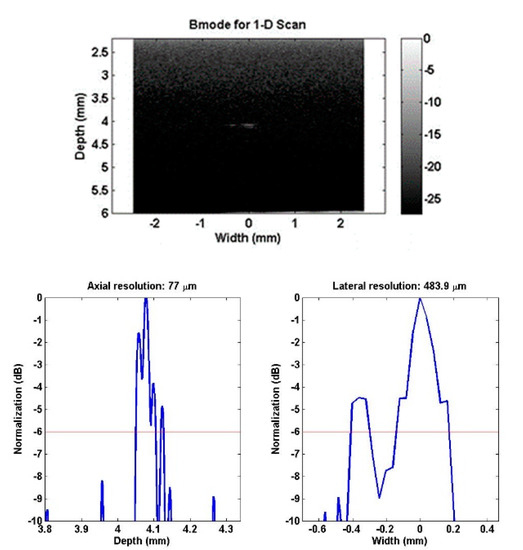
Figure 8.
Wire target image and −6 dB resolutions of BNT-BT transducer.
The axial resolution can be calculated according to Equation (5),
Using the −6 dB pulse length of 0.093 μs and the acoustic velocity of 1450 m/s, the axial resolution can be calculated to be 67 μm, which is close to the measured value of 77 μm. The lateral resolution is mainly determined by the width of the ultrasound beam. The BNT-BT thick film transducer was not focused, and this may be the cause of the relatively low lateral resolution.
3.3. Ultrasound Bio-Microscope Imaging
The preliminary imaging test was carried out by an ultrasound bio-microscope (SW 3200L, Suoer, Tianjin, China) and the dermatologic image captured is presented in Figure 9. The image from the skin of the back of a human hand was captured by the fabricated BNT-BT transducer without a matching layer. The imaging process was carried on in a deionized water bath, with the transducer scanning close and vertical to the skin surface. The layered structure can be distinguished in the image as the epidermis, dermis and subcutaneous tissue, in which the edge of the epidermis and dermis is not clear enough. The image captured by the BNT-BT transducer has relatively large sparkles indicating a relatively low resolution. The bandwidth of the BNT-BT transducer without a matching layer was 26%, so the imaging resolution was not very high. The BNT-BT transducer was not spherically focused and this also caused image quality decay.
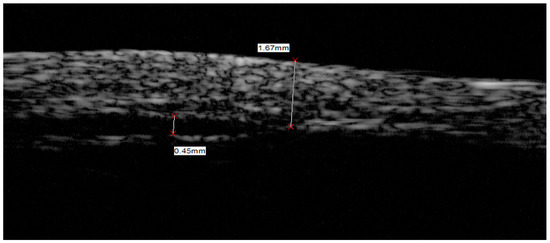
Figure 9.
Image of human skin from the back of the hand, generated by BNT-BT transducer using Ultrasound Bio-Microscope (UBM).
This trial showed that the BNT-BT transducer can be used in ultrasound imaging, and further improvement should be carried on to enhance the lead-free transducer performance with higher frequency which may be used in skin imaging.
4. Discussion
In this work, we utilized the piezoelectric tape-casting thick film technique for a high-frequency lead-free ultrasound transducer. The utilization of BNT-BT tape-casting thick film may avoid and simplify the lapping procedures currently used in the fabrication of high-frequency ultrasound transducers. A high frequency ultrasound transducer (35 MHz) was fabricated and tested using the lead-free piezoelectric thick film. The testing results indicated that the BNT-BT transducer exhibited relatively high sensitivity and resolution. However, the capabilities in regards to skin imaging still need to be enhanced. An increase in frequency will allow the resolution and contrast to be further improved, which can be achieved using the tape-casting piezoelectric thick film. A spherical focused transducer will also lead to higher imaging resolution and this could be easily realized.
5. Conclusions
In this paper, a high frequency ultrasound transducer was fabricated successfully based on a lead-free BNT-BT tape-casting thick film. The pulse-echo response performances showed that the BNT-BT thick film transducer had a center frequency of 34 MHz, and a fractional band width of 26%. The measured −6 dB resolutions estimated from the line spread functions were 77 μm in the axial direction and 484 μm in the lateral direction. The preliminary skin imaging test was tried using the BNT-BT transducer and an image of skin from the back of the hand was successfully captured. The experiment results suggest that the lead-free piezoelectric BNT-BT tape-casting thick film may be a promising candidate material for high frequency ultrasound transducer applications.
Author Contributions
Formal analysis, J.Z., Y.L., C.F. and Y.Q.; Funding acquisition, W.R.; Investigation, J.Z. and C.F.; Project administration, W.R.; Supervision, W.R., X.W. and Q.Z.; Writing—original draft, J.Z.; Writing—review & editing, W.R. and Q.Z.
Funding
This research was financially supported by the National Natural Science Foundation of China (Grant Nos. 51332003 and 51202184), International Science & Technology Cooperation Program of China (Grant Nos. 2010DFB13640 and 2011DFA51880), and the 111 Project of China (B14040).
Acknowledgments
The SEM work was done at International Center for Dielectric Research (ICDR), Xian Jiaotong University, Xi’an, China. The authors thank Yijun Zhang for his help in using SEM. The authors also thank Xingwei Yan for his help in transducer fabrication.
Conflicts of Interest
The authors declare no conflicts of interest.
References
- Li, X.; Wu, W.; Chung, Y.; Shih, W.Y.; Shih, W.-H.; Zhou, Q.; Shung, K.K. 80-MHz intravascular ultrasound transducer using PMN-PT free-standing film. IEEE Trans. Ultrason. Ferroelectr. Freq. Control 2011, 58, 2281–2288. [Google Scholar] [PubMed]
- Silverman, R.H.; Cannata, J.; Shung, K.K.; Gal, O.; Patel, M.; Lloyd, H.O.; Feleppa, E.J.; Coleman, D.J. 75 MHz ultrasound biomicroscopy of anterior segment of eye. Ultrason. Imaging 2006, 28, 179–188. [Google Scholar] [CrossRef] [PubMed]
- Ma, T.; Yu, M.; Chen, Z.; Fei, C.; Shung, K.K.; Zhou, Q. Multi-frequency intravascular ultrasound (IVUS) imaging. IEEE Trans Ultrason. Ferroelectr. Freq. Control 2015, 62, 97–107. [Google Scholar] [CrossRef] [PubMed]
- Passmann, C.; Ermert, H. A 100-MHz ultrasound imaging system for dermatologic and ophthalmologic diagnostics. IEEE Trans Ultrason. Ferroelectr. Freq. Control 1996, 43, 545–552. [Google Scholar] [CrossRef]
- Lukacs, M.; Sayer, M.; Foster, S. Single element high frequency (<50 MHz) PZT sol gel composite ultrasound transducers. IEEE Trans Ultrason. Ferroelectr. Freq. Control 2000, 47, 148–159. [Google Scholar] [CrossRef] [PubMed]
- Cannata, J.M.; Williams, J.A.; Zhou, Q.; Ritter, T.A.; Shung, K.K. Development of a 35-MHz piezo-composite ultrasound array for medical imaging. IEEE Trans Ultrason. Ferroelectr. Freq. Control 2006, 53, 224–236. [Google Scholar] [CrossRef] [PubMed]
- Foster, F.S.; Lockwood, G.R.; Ryan, L.K.; Harasiewicz, K.A.; Berube, L. Principles and applications of ultrasound backscatter microscopy. IEEE Trans Ultrason. Ferroelectr. Freq. Control 1993, 40, 608–617. [Google Scholar] [CrossRef] [PubMed]
- Foster, F.S.; Ryan, L.K.; Turnbull, D.H. Characterization of lead zirconate titanate ceramics for use in miniature high-frequency (20-80 MHz) transducers. IEEE Trans Ultrason. Ferroelectr. Freq. Control 1991, 38, 446–453. [Google Scholar] [CrossRef] [PubMed]
- Zhu, B.P.; Wu, D.W.; Zhou, Q.F.; Shi, J. Lead zirconate titanate thick film with enhanced electrical properties for high frequency transducer applications. Appl. Phys. Lett. 2008, 93, 012905. [Google Scholar] [CrossRef]
- Tadashi, T.; Kei-ichi, M.; Koichiro, S. (Bi1/2Na1/2)TiO3-BaTiO3 system for lead-free piezoelectric ceramics. Jpn. J. Appl. Phys. 1991, 30, 2236. [Google Scholar]
- Lau, S.T.; Ji, H.F.; Li, X.; Ren, W.; Zhou, Q.; Shung, K.K. KNN/BNT composite lead-free films for high-frequency ultrasonic transducer applications. IEEE Trans Ultrason. Ferroelectr. Freq. Control 2011, 58, 249–254. [Google Scholar] [PubMed]
- Yan, X.; Ji, H.; Lam, K.H.; Chen, R.; Zheng, F.; Ren, W.; Zhou, Q.; Shung, K.K. Lead-free BNT composite film for high-frequency broadband ultrasonic transducer applications. IEEE Trans Ultrason. Ferroelectr. Freq. Control 2013, 60, 1533–1537. [Google Scholar] [PubMed]
- Edwards, G.C.; Choy, S.H.; Chan, H.L.W.; Scott, D.A.; Batten, A. Lead-free transducer for non-destructive evaluation. Appl. Phys. A 2007, 88, 209–215. [Google Scholar] [CrossRef]
- Cannata, J.M.; Ritter, T.A.; Chen, W.H.; Silverman, R.H.; Shung, K.K. Design of efficient, broadband single-element (20-80 MHz) ultrasonic transducers. IEEE Trans Ultrason. Ferroelectr. Freq. Control 2003, 50, 1548–1557. [Google Scholar] [CrossRef] [PubMed]
- Zhu, B.; Zhang, Z.; Ma, T.; Yang, X.; Li, Y.; Shung, K.K.; Zhou, Q. (100)-Textured KNN-based thick film with enhanced piezoelectric property for intravascular ultrasound imaging. Appl. Phys. Lett. 2015, 106, 567–570. [Google Scholar] [CrossRef] [PubMed]
- IEEE Standard on Piezoelectricity; ANSI/IEEE Std 176-1987; IEEE: New York, NY, USA, 1988.
- Zhou, Q.; Lau, S.; Wu, D.; Shung, K.K. Piezoelectric films for high frequency ultrasonic transducers in biomedical applications. Prog. Mater. Sci. 2011, 56, 139–174. [Google Scholar] [CrossRef] [PubMed]
© 2018 by the authors. Licensee MDPI, Basel, Switzerland. This article is an open access article distributed under the terms and conditions of the Creative Commons Attribution (CC BY) license (http://creativecommons.org/licenses/by/4.0/).